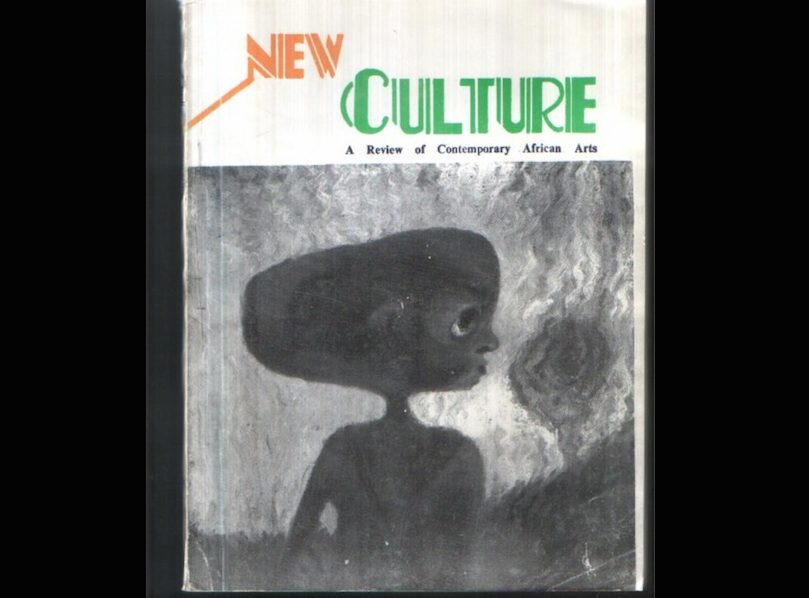C& is happy to publish this feature by Bisi Silva as second part of a collaboration with the Manifesta Journal: This was initially published in the Journals’ current issue “Future(s) of Cohabitation” .

New Culture Mag, January 1997. Courtesy of New Culture Studios.
One of the lingering consequences of the failure of the postcolonial state is the inadequate investment in the development of education. With the rise of authoritarian and dictatorial regimes from the late 1970s to the late 1990s, the frontline attack was on academia and any form of intellectual life. The plethora of journals, magazines and reviews that were propelled by the euphoria of the independence period were soon to be consigned to obsolescence. Nonetheless, a few have been able to reinvent themselves, outside of the continent. Some of the well known pan-African titles—which focused on art, culture, politics and society—included Drum Magazine, Black Orpheus and Transition,1 and they complemented the scholarship that was coming out of the dynamic University presses from across the continent at the time. My discovery of New Culture: A Review of Contemporary African Arts highlights the informational vacuum that exists with regards to critical endeavors in the past. Until Janet Stanley, Chief Librarian at the National Museum of African Art, Smithsonian Institute, offered to provide the library of the CCA, Lagos2 with copies of the publication, I was not aware of the existence of the review. Only eleven issues underline its brief existence over a fifteen-month period in the late 1970s. During this period in Nigeria a handful of defunct magazines stood out for their focus on the arts, such as Nigeria Magazine3 and Uso: Nigerian Journal of Art4. New Culture: A Review of Contemporary African Art placed a particularly strong emphasis on the visual arts. It started with an illustrious editorial team that consisted of important artists based both on the continent and elsewhere as part of the diaspora, such as the American sculptor Melvin Edwards, the London based artist Taiwo Jegede, and Nigerian artists such as Demas Nwoko (founder) and Uche Okeke, who were subsequently joined by Ola Oloidi, the art historian and professor at the University of Nigeria. New Culture Mag, November 1978, 1979. Courtesy of New Culture Studios. New Culture Mag, November 1978, 1979. Courtesy of New Culture Studios. The review delved into many such issues such as identity, colonialism, post colonialism, as well as history and tradition as they came to highlighting the new African reality, and the way these were engaged by the artists in their work. The key section of the review focused on the aesthetics of African Art and Culture, which propounded a return to the study of traditional art— which the founder, artist, architecture, poet and writer, Demas Nwoko (1935 – ) considered to be the “only one art stylistic idiom… valid to the African and the Blacks of African descent the world over, its origin being the too well-known form of traditional African arts, a form that was created and nurtured to maturity by African people themselves, with a history that dates beyond 2000 years.” In espousing a return to the past he also acknowledged the need for “a new aesthetic position relevant to our time.”5 To achieve these objectives, the reviewers covered the arts across the continent. The drawings by Sudanese artist Ibrahim El Salahi (1930– ) that were featured in the May 1979 issue are such an example, as they reached out to the diaspora. The eleven editions are filled with reviews and essays, in addition to containing a vibrant children’s section that makes palpable the dynamism of the cultural and creative sector of the period. The exhibition review I found to be the most illuminating was that of Theresa Luck-Akinwale (1934– ),6 one of the few trained female artists in Nigeria who still remains inadequately represented in the history of Nigerian Art. As such, the eleven editions constitute an indispensable archive of our cultural life in a context where such information remains difficult to find. Title refers to: Volume 1, no. 1, November 1978, through Volume 1, no. 11, October 1979. . . C& is happy to publish this review as second part of a collaboration with the Manifesta Journal: The review was initially published in the Journals’ current issue “Future(s) of Cohabitation” .
Drum Magazine (initially called African Drum) was started in South Africa in 1951 by Bob Crisp and Jim Bailey. It was a lifestyle magazine that targeted the Black population. However it became popular for its coverage of township life under apartheid in the 1950s and 1960s. Black Orpheus was founded in 1957 in Nigeria by German expatriate Ulli Beier as a journal of African and Afro-American literature. Transition: A Journal of Arts, Culture and Society was started in Kampala, Uganda in 1961 by Rajat Neogy as a platform for East African intellectuals.
Full disclosure, the writer is the director of CCA, Lagos. http://www.ccalagos.org, accessed December 23, 2013.
Nigeria Magazine may be the longest running arts and culture magazine in Africa. It was founded in the 1930s and the final volume was in 1990.
USO: Nigerian Journal of Art came out sporadically, only managing to release three publications in three Volumes (one edition per year) between December 1995 and December 2001.
New Culture Magazine (November 1978), 1.
Pat Oyelola. 1979. “The Art of Theresa Luck Akinwale”, New Culture Magazine, 21.
More Editorial